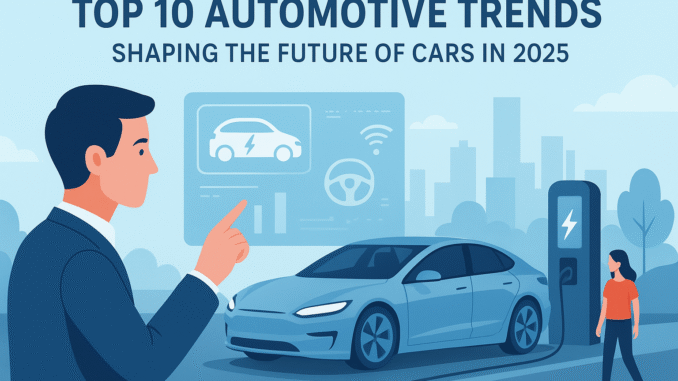
Top 10 Automotive Trends Shaping the Future of Cars in 2025
The automotive industry is moving faster than ever before. With technology, sustainability, and customer expectations driving change, cars in 2025 will be more advanced, connected, and eco-friendly than anything we’ve seen before. From electric mobility to AI-powered driving, the future of transportation is being shaped right now.
In this article, we’ll explore the top 10 automotive trends shaping the future of cars in 2025 and what they mean for drivers, manufacturers, and the world at large.
1. Electric Vehicles Becoming the New Normal
Electric vehicles (EVs) are no longer just a niche choice. By 2025, many countries will push for stricter emissions regulations, and automakers are shifting rapidly toward electrification. Brands like Tesla, BYD, and Volkswagen are leading the EV race, while traditional giants like Toyota and Ford are launching more electric models every year.
With improvements in battery technology, charging infrastructure, and affordability, EV adoption is set to skyrocket. Consumers will benefit from lower running costs, government incentives, and a cleaner alternative to gasoline-powered cars.
Key takeaway: In 2025, EVs will not just be an option—they’ll be the standard for many new car buyers.
2. Autonomous Driving Advancements
Self-driving cars are still evolving, but 2025 will bring significant improvements. Companies like Waymo, Tesla, and NVIDIA are refining autonomous systems powered by AI and machine learning.
While fully driverless cars may still be years away, we’ll see more vehicles equipped with Level 3 and Level 4 automation, meaning cars can handle driving tasks in specific conditions with minimal human input.
Expect features such as advanced lane-keeping, automated parking, and adaptive cruise control to become mainstream, making driving safer and more convenient.
Key takeaway: Semi-autonomous features will reduce accidents and make driving stress-free.
3. Connected Cars and Smart Mobility
The rise of the Internet of Things (IoT) is transforming vehicles into smart devices on wheels. Connected cars in 2025 will offer seamless integration with smartphones, smart homes, and even city infrastructure.
This trend means drivers can expect:
- Real-time traffic updates
- Over-the-air software updates
- Remote diagnostics and maintenance alerts
- Personalized infotainment experiences
By connecting cars to a larger digital ecosystem, automakers aim to improve convenience, efficiency, and safety.
Key takeaway: Cars in 2025 will be smarter, connected, and able to “communicate” with the world around them.
4. Sustainability and Green Manufacturing
Sustainability goes beyond electric cars. Automakers are now focusing on eco-friendly manufacturing, recyclable materials, and reduced carbon footprints.
In 2025, expect to see more vehicles built with lightweight composites, recycled plastics, and bio-based materials. Car companies will also invest in renewable energy for production facilities, making vehicles cleaner from start to finish.
Key takeaway: Sustainability will define not only the cars we drive but also how they are built.
5. Advanced Safety Features
Road safety remains a top priority, and 2025 will bring a new wave of driver-assistance systems. Cars will feature technologies like:
- Collision avoidance systems
- Pedestrian detection
- Blind-spot monitoring
- 360-degree cameras
- Automatic emergency braking
By combining sensors, radar, and AI, vehicles will become better at preventing accidents rather than just protecting passengers during crashes.
Key takeaway: Cars will prioritize prevention, making roads safer for everyone.
6. Shared Mobility and Subscription Services
Car ownership is changing. By 2025, many urban dwellers will prefer car-sharing, ride-hailing, and subscription-based car models instead of traditional ownership.
Subscription services will allow customers to switch between vehicles—say an SUV for a road trip and a compact car for city driving—without long-term commitments. This shift is driven by cost efficiency, convenience, and environmental awareness.
Key takeaway: Flexible mobility options will reshape how people access and use cars.
7. Artificial Intelligence and Personalization
AI will play a critical role in shaping the driving experience in 2025. Cars will learn from driver behavior, preferences, and routines, creating a personalized journey every time.
For example, AI can adjust seat positions, climate control, and navigation routes based on driver habits. Voice assistants will become smarter, offering hands-free control for nearly every feature inside the vehicle.
Key takeaway: Cars will feel more personal, adapting to individual lifestyles.
8. Faster Charging and Battery Innovation
One of the biggest barriers to EV adoption has been charging time. By 2025, ultra-fast charging stations and solid-state batteries will begin to change the game.
Solid-state batteries promise longer ranges, quicker charging, and better safety compared to lithium-ion batteries. Automakers are heavily investing in this technology, and while mass adoption may take time, 2025 will mark major breakthroughs.
Key takeaway: Charging an EV will become as fast and convenient as refueling a traditional car.
9. Integration of Augmented Reality (AR)
Augmented reality will make driving more immersive and safe. In 2025, many vehicles will come with AR-powered windshields and dashboards.
These systems will project:
- Real-time navigation arrows on the road
- Hazard warnings
- Speed limits and traffic signs
- Points of interest
This will help drivers stay focused on the road without distraction, merging digital information with the physical environment.
Key takeaway: AR will transform how drivers interact with the road, blending technology with reality.
10. Growth of Hydrogen and Alternative Fuels
While EVs dominate the headlines, hydrogen fuel cell vehicles (FCEVs) and alternative fuels will also grow in importance by 2025. Hydrogen cars provide long ranges and quick refueling, making them attractive for commercial fleets and heavy-duty transport.
Countries like Japan and South Korea are leading hydrogen adoption, and more infrastructure will be built globally. Additionally, synthetic and biofuels may support the transition for industries where full electrification is difficult.
Key takeaway: Hydrogen and alternative fuels will complement EVs in building a cleaner transportation future.
Final Thoughts
The automotive world in 2025 will be defined by innovation, sustainability, and connectivity. From electric mobility to AI-driven personalization, cars are evolving into smarter, greener, and safer machines.
These top 10 trends—EV adoption, autonomous driving, connectivity, sustainability, safety features, shared mobility, AI personalization, battery breakthroughs, augmented reality, and hydrogen fuel—are not just shaping the future; they are redefining how we move, live, and interact with technology.
For drivers, this means more convenience, efficiency, and eco-friendly options. For the industry, it’s a race to innovate faster than ever before.
The future of cars isn’t just coming—it’s already here. 🚗⚡
